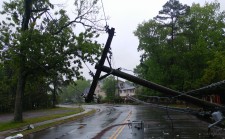Grid Operators Get Ready for Climate Change

KARLSRUHE, Germany, February 11, 2020 (Newswire.com) - UBIMET helps grid operators minimize risk. Germany is the country third most affected by extreme weather worldwide.
Extreme weather events cause more power outages
In 2018, in Germany, extreme weather-induced damages amounted to 4.5 billion EUR. This concerns power grids in particular. According to the regulator Federal Network Agency, the average length of severe weather-induced power failures rose significantly from 12.8 to 15.14 minutes in 2017, compared to 2016, but decreased again to 13.9 in 2018.
2019 turned out to be a challenging year. Autumn storm Amalie cut the power supply of 140,000 households in southwestern France with hurricane-like winds in early November. The same month, enormous amounts of wet snow caused the entire power grid in the Austrian province East Tyrol to collapse. A severe storm had previously hit the port city Genoa in Northern Italy and paralyzed large parts of the grid.
Lightning hazard and liability risks
Lightning strikes and storms constitute severe challenges for grid operators. Lightning activity often causes disruptions, whereas storms can result in significant compensation payments — the latter because power cuts with wind speed levels of less than 10 are legally not recognized as force majeure. Grid operators are obliged to provide full compensation.
Renowned grid operators, such as 50Hertz or Syna, therefore rely on high-quality customized solutions. "Syna obtains extensive meteorological information for the grid control system from UBIMET. They also include real-time lightning data and severe weather warnings for the entire grid area. Reliable data in real-time, providing the highest accuracy, is essential for us as a distribution grid operator," says Jurgen Kochling, technical manager of Syna, Suwag’s subsidiary for grid operations.
Heat waves endanger grid stability
Temperature extremes are on the rise as well. "Just think about last summer in Germany with temperatures above 40 degrees for days," states Alexander Lehmann, experienced meteorologist and managing director of UBIMET’s energy competence center in Karlsruhe. The warmer it gets, the more critical the transmission grid’s condition becomes, as overhead lines are only designed for operations of up to 35 degrees. They need to be monitored to avoid critical situations.
The rapid growth of renewables massively increases the need to transport electricity. According to a renowned transmission grid operator, overhead line monitoring can increase transmission capacity of existing lines by up to 80%. A necessary precondition to achieve this is precise weather data along its route. UBIMET currently provides it in a resolution of 100m.
PrognoNetz: AI improving transmission capacity
Together with transmission grid operator TransnetBW, UBIMET is working to further improve overhead line monitoring. "The research project PrognoNetz will enable smart power lines by using AI to optimally adapt electricity flow to weather conditions in real-time and provide higher transmission capacity," explains TransnetBW CEO Dr. Werner Gotz.
Contact: Karin Schwarz, kschwarz@ubimet.com
Source: UBIMET